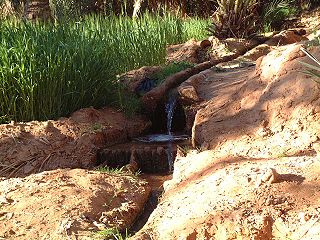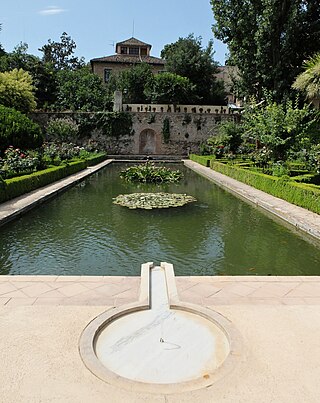
The Alhambra is a palace and fortress complex located in Granada, Andalusia, Spain. It is one of the most famous monuments of Islamic architecture and one of the best-preserved palaces of the historic Islamic world, in addition to containing notable examples of Spanish Renaissance architecture.

Granada is the capital city of the province of Granada, in the autonomous community of Andalusia, Spain. Granada is located at the foot of the Sierra Nevada mountains, at the confluence of four rivers, the Darro, the Genil, the Monachil and the Beiro. Ascribed to the Vega de Granada comarca, the city sits at an average elevation of 738 m (2,421 ft) above sea level, yet is only one hour by car from the Mediterranean coast, the Costa Tropical. Nearby is the Sierra Nevada Ski Station, where the FIS Alpine World Ski Championships 1996 were held.

In religion, paradise is a place of exceptional happiness and delight. Paradisiacal notions are often laden with pastoral imagery, and may be cosmogonical or eschatological or both, often compared with the miseries of human civilization: in paradise there is only peace, prosperity, and happiness. Paradise is a place of contentment, a land of luxury and fulfillment containing ever-lasting bliss. Paradise is often described as a "higher place", the holiest place, in contrast to this world, or underworlds such as Hell.

An alcázar, from Arabic al-Qasr, is a type of Islamic castle or palace in Spain built during Muslim rule between the 8th and 15th centuries. They functioned as homes and regional capitals for governmental figures throughout the Umayyad caliphate and later, for Christian rulers following the Iberian Reconquista. The term alcázar is also used for many medieval castles built by Christians on earlier Roman, Visigothic or Islamic fortifications and is frequently used as a synonym for castillo or castle. In Latin America there are also several colonial palaces called Alcázars.

Shajar al-Durr, also Shajarat al-Durr, whose royal name was al-Malika ʿAṣmat ad-Dīn ʾUmm-Khalīl Shajar ad-Durr, was a ruler of Egypt. She was the wife of As-Salih Ayyub, and later of Izz al-Din Aybak, the first sultan of the Mamluk Bahri dynasty. Prior to becoming Ayyub's wife, she was a child slave and Ayyub's concubine.

A charbagh or chaharbagh is a Persian and Indo-Persian quadrilateral garden with a layout comprising four gardens traditionally separated by waterways, together representing the four gardens and four rivers of Paradise mentioned in the Quran. The chaharbagh may also be divided by walkways instead of flowing water. Such gardens are found in countries throughout West Asia, South Asia, North Africa and the former al-Andalus. A famous example of charbagh is the charbagh of the Taj Mahal in India.

The Court of the Lions (Spanish: Patio de los Leones) or Palace of the Lions is a palace in the heart of the Alhambra, a historic citadel formed by a complex of palaces, gardens and forts in Granada, Spain. It was commissioned by the Nasrid sultan Muhammed V of the Emirate of Granada in Al-Andalus. Its construction started in the second period of his reign, between 1362 and 1391 AD. Along with the Alhambra, the palace is part of a UNESCO World Heritage Site. It was minted in Spain's 2011 limited edition of €2 Commemorative Coins.

The Generalife was a summer palace and country estate of the Nasrid rulers of the Emirate of Granada in Al-Andalus. It is located directly east of and uphill from the Alhambra palace complex in Granada, Spain.
Eram Garden is a historic Persian garden in Shiraz, Iran. The garden, and the building within it, are located at the northern shore of the Khoshk River in the Fars province.

An Islamic garden is generally an expressive estate of land that includes themes of water and shade. Their most identifiable architectural design reflects the charbagh quadrilateral layout with four smaller gardens divided by walkways or flowing water. Unlike English gardens, which are often designed for walking, Islamic gardens are intended for rest, reflection, and contemplation. A major focus of the Islamic gardens was to provide a sensory experience, which was accomplished through the use of water and aromatic plants.

The Arab Agricultural Revolution was the transformation in agriculture in the Old World during the Islamic Golden Age. The agronomic literature of the time, with major books by Ibn Bassal and Abū l-Khayr al-Ishbīlī, demonstrates the extensive diffusion of useful plants to Medieval Spain (al-Andalus), and the growth in Islamic scientific knowledge of agriculture and horticulture. Medieval Arab historians and geographers described al-Andalus as a fertile and prosperous region with abundant water, full of fruit from trees such as the olive and pomegranate. Archaeological evidence demonstrates improvements in animal husbandry and in irrigation such as with the saqiyah waterwheel. These changes made agriculture far more productive, supporting population growth, urbanisation, and increased stratification of society.

Dayfa Khatun was a Kurdish Ayyubid princess, and the regent of Aleppo from 26 November 1236 to 1242, during the minority of her grandson An-Nasir Yusuf. She was an Ayyubid princess, as the daughter of Al-Adil, Sultan of Egypt. She married her first cousin, Az-Zahir Ghazi, Emir of Aleppo, which marked the end of the rivalry between the two branches of the family.

Enid Haupt was an American publisher and philanthropist whose gifts supported horticulture, the arts, architectural and historic preservation, and cancer research. She has been described as "the greatest patron American horticulture has ever known" by Gregory Long, the president of the New York Botanical Garden.
Islamic Art: Mirror of the Invisible World is a PBS documentary film that showcases the variety and diversity of Islamic art. It discusses Islamic culture and its role in the rise of world civilization over the centuries. It was produced in 2011 by Alex Kronemer and Michael Wolfe of Unity Productions Foundation.
Houria Niati is an Algerian contemporary artist living in London. Niati specializes in mixed media installations that criticize Western representations and objectification of north African and Middle Eastern women. Her installations notably have live performances most commonly traditional Algerian music such as Raï, as a key visual representation of Niati's homeland and culture. Salah M. Hassan further details her performances, "She uses synthesizers, sound recordings, and special light effects to create a theatrical atmosphere and a vibrant magical environment of sound, body movement, and color." The installations and exhibitions join together paintings, sculptures, drawings, photos, soundtracks, and performances.

The Mashhad of Sayyida Ruqayya, sometimes referred to as the Mausoleum or Tomb of Sayyida Ruqayya, is a 12th-century Islamic religious shrine and mosque in Cairo, Egypt. It was erected in 1133 CE as a memorial to Ruqayya bint Ali, a member of the Islamic prophet Muhammad's family. It is also notable as one of the few and most important Fatimid-era mausoleums preserved in Cairo today.

Partal Palace is a palatial structure inside the Alhambra fortress complex located in Granada, Spain. It was originally built in the early 14th century by the Nasrid ruler Muhammad III, making it the oldest surviving palatial structure in the Alhambra.

The Mausoleum of Shajar al-Durr is a mausoleum housing the tomb of the female Ayyubid sultan Shajar al-Durr in Cairo, Egypt. It is located on al-Khalifa Street or Shurafa Street, in a neighbourhood on the edge of the al-Qarafa cemeteries. Its construction was commissioned by Shajar al-Durr herself and it is believed to have been built in the Islamic year 648 AH. Shajar al-Durr was notable for being the only female Muslim ruler in Egyptian history and for playing a crucial role in the transition from Ayyubid rule to Mamluk rule. The mausoleum serves as the formal resting place of the queen and commemorates her legacy. Architectural features of this structure, along with the broader architectural patronage of Shajar al-Durr, influenced future Mamluk architecture.

The Palacio del Partal Alto, also known as the Palacio de Yusuf III or the Palacio del Conde del Tendilla, is a former palace in the Alhambra, the historic citadel of Granada, Spain. It is the oldest palace in the Alhambra for which any remains have been found. It was built in the reign of the Nasrid ruler Muhammad II. After the conquest of Granada in 1492 it became the residence of the Count of Tendilla, the governor of the Alhambra, until it was confiscated by Philip V in 1717 and subsequently demolished. After excavations in the 20th century, a part of the palace's foundations are visible today in the Partal Gardens.

A mirador is a Spanish term designating a lookout point or a place designed to offer extensive views of the surrounding area. In an architectural context, the term can refer to a tower, balcony, window, or other feature that offers wide views. The term is often applied to Moorish architecture, especially Nasrid architecture, to refer to an elevated room or platform that projects outwards from the rest of a building and offers 180-degree views through windows on three sides. The equivalent term in Arabic is bahw or manāẓir/manẓar.


















